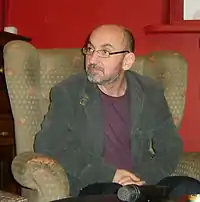Fatos Lubonja
Fatos Lubonja (born 1951) is an Albanian writer, analyst and dissident.[1]

Life
Fatos, son of Todi Lubonja, who was a close associate of Enver Hoxha and head of Albanian national television until the early 1970s, is an Albanian political analyst. In the course of Hoxha's split with the USSR in 1960, Todi Lubonja was arrested for voicing opposition. Fatos, who had been studying physics in Tirana, was also arrested due to the discovery of his diary, which was very critical of Hoxha.
Fatos Lubonja was initially sentenced to seven years' imprisonment. He was accused of belonging to a pro-Soviet circle in the prison and was sentenced to twenty more years. After having spent thirteen years at hard labor, he was moved to solitary confinement. There he wrote a diary and a novel on cigarette paper, which was concealed in the spine of a dictionary. His novel The Last Massacre is a take on communism under Hoxha.
Fatos Lubonja was released in 1991, after having spent seventeen years in prison and having suffered a nervous breakdown, while serving his sentence. He is an outspoken critic of the Albanian socio-political factors, i.e. right-wing leader Sali Berisha, Socialist Party leader Edi Rama, former KLA leader Ramush Haradinaj, Red and Black Alliance, and poet and novelist Ismail Kadare. He edits and publishes the literary magazine Përpjekja (Endeavour) in Tirana, which was founded by him in 1994.[2][3]
Lubonja is the recipient of the SEEMO Award for Mutual Cooperation in South East Europe in 2004.[4]
Translated into English
"False Apocalypse" published in London by Istros Books in 2014, with foreword by Guardian journalist and author, Andrew Gumble.
References
- Bernard A. Cook (2001). "Lubonja, Fatos". In Bernard A. Cook (ed.). Europe since 1945: An Encyclopedia. 2. Garland Publishing. p. 797.
- "Arts and Culture Program". Open Society Foundation. Retrieved 3 May 2015.
- "Fatos Lubonja". Words without Borders. Retrieved 3 May 2015.
- "Human Rights Award 2004". SEEMO. Archived from the original on 4 March 2016. Retrieved 3 May 2015.